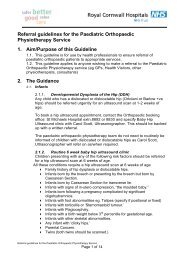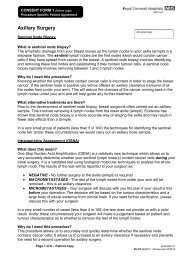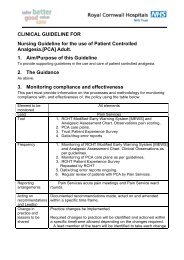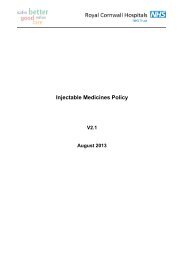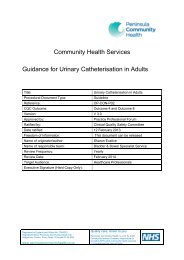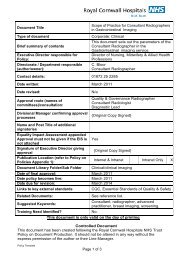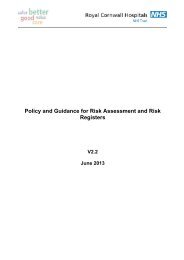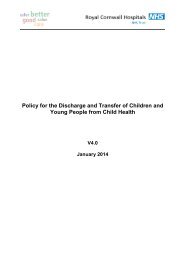Policy for Recordings and Photography - the Royal Cornwall ...
Policy for Recordings and Photography - the Royal Cornwall ...
Policy for Recordings and Photography - the Royal Cornwall ...
You also want an ePaper? Increase the reach of your titles
YUMPU automatically turns print PDFs into web optimized ePapers that Google loves.
Document TitleType of document<strong>Policy</strong> <strong>for</strong> <strong>Recordings</strong> <strong>and</strong> <strong>Photography</strong>Corporate: Non ClinicalBrief summary of contentsExecutive Director responsible <strong>for</strong><strong>Policy</strong>:Directorate / Department responsible(author/owner):<strong>Policy</strong> <strong>for</strong> <strong>Recordings</strong> <strong>and</strong> <strong>Photography</strong>This <strong>Policy</strong> ensures that all recordings,whe<strong>the</strong>r originating in <strong>the</strong> Medical<strong>Photography</strong> Department, or using camerasowned by departments within <strong>the</strong> Trust, whichillustrate a patient’s condition or an aspect of<strong>the</strong> treatment, <strong>for</strong>m a part of that patient’shealth record <strong>and</strong> are protected in <strong>the</strong> sameway as any o<strong>the</strong>r health record. In this <strong>Policy</strong>,<strong>the</strong> term “recording” (or “recordings”) is usedto refer to photography (ei<strong>the</strong>r conventional ordigital), video recording (ei<strong>the</strong>r conventional ordigital), clinical imaging <strong>and</strong> voice recordingsin Speech <strong>and</strong> Language Therapy.It refers to originals <strong>and</strong>/or copiesDirector of FinanceContact details: 01872 254500Date written: 8 September 2005Date revised: 19 April 2012Approval route (names ofcommittees)/consultation:Divisional Manager confirming approvalprocessesName <strong>and</strong> Post Title of additionalsignatoriesEquality Impact Assessment appendedApproval must not be given if <strong>the</strong> EIS isnot attachedSignature of Executive Director givingapprovalPublication Location (refer to <strong>Policy</strong> onPolicies Appendix 1):Document Library Folder/Sub FolderKim Bellis, Records Services, PAS & DataQuality Manager, Health In<strong>for</strong>matics <strong>and</strong> ICTIn<strong>for</strong>mation Governance CommitteeHealth Records User GroupConsultants in Child Health, Breast Surgery,Clinical ImagingMedical <strong>Photography</strong>Dermatology DepartmentNot applicableNot applicableYesPage 1 of 25{Original Copy Signed}Internet & Intranet X Intranet OnlyHealth In<strong>for</strong>matics
Date of final approval: 27 July 2011Date policy becomes live: 1 August 2011Date due <strong>for</strong> revision: 1 August 2014Links to key external st<strong>and</strong>ardsRelated Documents:Suggested Keywords:Training Need Identified?NHS Litigation AuthorityCare Quality Commission – Outcome 21In<strong>for</strong>mation Governance ToolkitPatient Record <strong>and</strong> In<strong>for</strong>mation ManagementAccreditation ProgrammeData Protection Act 1998Access to Health Records Act 1990NHS Code of ConfidentialityNHS Records Management Code of PracticeGMC Guidance Making <strong>and</strong> using visual <strong>and</strong>audio recordings of patientsRCHT:In<strong>for</strong>mation Governance <strong>Policy</strong>Managing Health Records <strong>Policy</strong>Clinical Record Keeping <strong>Policy</strong>Data Protection <strong>Policy</strong>Photographers, <strong>Photography</strong>, Photographicequipment, Photographs, Imaging, Imaging[digital], Imaging [medical], Video cameras,Video recording, Video recordings, Videotapes, Videos, Audio recordings, Audio tapes,Medical photographers, Medical photographicequipment, Medical photography, Medicalphotography departments, <strong>Recordings</strong>NoThis document is only valid on <strong>the</strong> day of printingControlled DocumentThis document has been created following <strong>the</strong> <strong>Royal</strong> <strong>Cornwall</strong> Hospitals NHS Trust<strong>Policy</strong> on Document Production. It should not be altered in any way without <strong>the</strong>express permission of <strong>the</strong> author or <strong>the</strong>ir Line Manager.<strong>Policy</strong> <strong>for</strong> <strong>Recordings</strong> <strong>and</strong> <strong>Photography</strong>Page 2 of 25
<strong>Policy</strong> <strong>for</strong> <strong>Recordings</strong> <strong>and</strong> <strong>Photography</strong>V2.419 April 12<strong>Policy</strong> <strong>for</strong> <strong>Recordings</strong> <strong>and</strong> <strong>Photography</strong>Page 3 of 25
Version Control TableDateVersionNoSummary of Changes8 Sep 05 V1.0 Original document created10 Nov 10 V2.0 First major revision4 April 11 V2.1Formatted to <strong>Policy</strong> on Policies st<strong>and</strong>ardtemplateInclude Internal Audit recommendations6 June 11 V2.2 Include update from GMC guidance issued27 June 11 V2.3 Include comments from consultation <strong>and</strong>change name of <strong>Policy</strong>19 April 12 V2.4 Updated to reflect changes as a result of aSerious Incident – availability of digitalcameras out of normal office hoursChanges Made by(Name <strong>and</strong> Job Title)Kim BellisRecords Services MgrKim BellisRecords Services MgrAndrew RogersCorporate RecordsManagerKim BellisRecords Services & PASManagerKim BellisRecords Services & PASManagerKim BellisRecords Services & PASManagerKim BellisRecords Services, PAS<strong>and</strong> Data Quality ManagerAll or part of this document can be released under <strong>the</strong> Freedom of In<strong>for</strong>mation Act2000This document is to be retained <strong>for</strong> 10 years from <strong>the</strong> date of expiry.<strong>Policy</strong> <strong>for</strong> <strong>Recordings</strong> <strong>and</strong> <strong>Photography</strong>Page 1 of 25
NHS UnclassifiedTable of ContentsVersion Control Table...................................................................................................11. Introduction...............................................................................................................32. Purpose of this <strong>Policy</strong> ...............................................................................................33. Scope .......................................................................................................................34. Definitions / Glossary................................................................................................35. Ownership <strong>and</strong> Responsibilities................................................................................36. St<strong>and</strong>ards <strong>and</strong> Practice ............................................................................................46.5. Confidentiality....................................................................................................46.9. Consent .............................................................................................................56.43. Processing ...................................................................................................106.52. Storage <strong>and</strong> disposal. ..................................................................................116.59. Disclosure of <strong>Recordings</strong> .............................................................................116.61. Copyright......................................................................................................127. Dissemination <strong>and</strong> Implementation.........................................................................128. Monitoring compliance <strong>and</strong> effectiveness...............................................................129. Updating <strong>and</strong> Review..............................................................................................1410. Equality <strong>and</strong> Diversity..........................................................................................1410.2. Equality Impact Assessment........................................................................14Appendix 1. General Consent to Recording...................................................................15Appendix 2. Genito Urinary Medicine Consent to Recording.........................................17Appendix 3. Request <strong>for</strong> Medical Photograph................................................................19Appendix 4. Initial Equality Impact Assessment Screening Form ..................................20<strong>Policy</strong> <strong>for</strong> <strong>Recordings</strong> <strong>and</strong> <strong>Photography</strong>Page 2 of 25
NHS Unclassified1. Introduction1.1. It is essential that <strong>the</strong> Trust respects <strong>the</strong> confidentiality of patients <strong>and</strong> staff<strong>and</strong>, in so doing, abides with <strong>the</strong> requirements of <strong>the</strong> Data Protection Act, o<strong>the</strong>rextant legislation <strong>and</strong> Trust policies. This legislation dem<strong>and</strong>s that images <strong>and</strong>recordings are treated in <strong>the</strong> same way as o<strong>the</strong>r personal data however, <strong>the</strong>serecordings require different h<strong>and</strong>ling arrangements due to <strong>the</strong> amount ofin<strong>for</strong>mation that <strong>the</strong>y contain <strong>and</strong> <strong>the</strong> ability of such recordings to be manipulated.1.2. This version supersedes any previous versions of this document.2. Purpose of this <strong>Policy</strong>2.1. This policy is intended to st<strong>and</strong>ardise <strong>the</strong> way that Trust staff h<strong>and</strong>le images<strong>and</strong> recordings to ensure that confidentiality is maintained <strong>and</strong> that <strong>the</strong> Trust canmeet its obligations with respect extant legislation.3. Scope3.1. This policy applies to all Trust staff members undertaking <strong>the</strong> capture,processing, storage <strong>and</strong> retrieval of images <strong>and</strong> recordings in <strong>the</strong> course of <strong>the</strong>irduties. This includes recordings made:• On healthcare premises within or outside <strong>the</strong> UK (including Theatres) <strong>and</strong>/or• As part of <strong>the</strong> assessment, investigation or treatment of patients’ conditions orillness <strong>and</strong> may include video links in Theatres, <strong>and</strong>/or• For purposes such as teaching, training or assessment of healthcareprofessionals <strong>and</strong> students, research, or o<strong>the</strong>r health-related uses which are notdesigned to benefit <strong>the</strong> patient directly, described as ‘secondary purposes’4. Definitions / Glossary4.1. Recording. Recording refers to clinical imaging, photography, video <strong>and</strong>voice recordings in Speech <strong>and</strong> Language Therapy but excludes recordings oftelephone conversations, pathology slides containing human tissue or CCTVrecordings of public areas in hospitals. This includes mobile phones. Within <strong>the</strong>context of this policy recordings may be:Conventional (analogue) or digital;Originals or copies<strong>Recordings</strong> in this guidance does not include pathology slides containing humantissue. Photographs of slides may be made without consent <strong>for</strong> <strong>the</strong> purpose ofcare or treatment of patient, or <strong>for</strong> secondary purpose, provided that images areanonymised or coded.5. Ownership <strong>and</strong> Responsibilities5.1. Role of <strong>the</strong> Managers5.2. Line managers are responsible <strong>for</strong>:<strong>Policy</strong> <strong>for</strong> <strong>Recordings</strong> <strong>and</strong> <strong>Photography</strong>Page 3 of 25
NHS UnclassifiedEnsuring that any of <strong>the</strong>ir staff members involved with <strong>the</strong> capture, processing,storage <strong>and</strong> retrieval of audio, video <strong>and</strong> photographic recordings are aware of,<strong>and</strong> comply with, this policy.To notify <strong>the</strong> Records Services & PAS Manager if recordings are undertaken inyour department (not <strong>for</strong> each <strong>and</strong> every individual recording)5.3. Role of Individual Staff5.4. All staff members are responsible <strong>for</strong>:Ensuring that <strong>the</strong>ir Line Manager is aware of any audio, video <strong>and</strong>photographic recording activity in <strong>the</strong>ir work area.To notify <strong>the</strong> Records Services & PAS Manager if recordings are undertaken inyour departmentEnsuring that <strong>the</strong>y abide by this policy if <strong>the</strong>y are involved with any audio, video<strong>and</strong> photographic recording activity.Reporting any breaches of this policy to <strong>the</strong> Records Services <strong>and</strong> PASManager.Medical Staff are reminded that serious or persistent failure to follow this policywhich is based upon GMC Guidance may put <strong>the</strong>ir registration at risk6. St<strong>and</strong>ards <strong>and</strong> Practice6.1. <strong>Recordings</strong>, whe<strong>the</strong>r originating in <strong>the</strong> Medical <strong>Photography</strong> Department orusing cameras purchased <strong>for</strong> departments use (<strong>and</strong> sometimes purchased fromcharitable funds), which illustrate a patient’s condition or an aspect of <strong>the</strong>treatment, <strong>for</strong>m a part of that patient’s health record <strong>and</strong> are protected in <strong>the</strong> sameway as any o<strong>the</strong>r health record.6.2. Under no circumstances should staff use <strong>the</strong>ir mobile phones or personalcameras to record images.6.3. Freelance professional photographers are sometimes employed to make thissort of recording. They may only be introduced to The <strong>Royal</strong> <strong>Cornwall</strong> HospitalNHS Trust by arrangement with <strong>the</strong> Press Officer or Director of Communications.6.4. All equipment used <strong>for</strong> recordings must be purchased through <strong>the</strong> <strong>Cornwall</strong>IT Services Helpdesk. Your request will be logged <strong>and</strong> <strong>the</strong> Records Services &PAS Manager will contact you to seek assurance of your compliance with thispolicy specifically around <strong>the</strong> use, storage, security <strong>and</strong> access of images. Oncethis has been established approval will be given to purchase <strong>the</strong> equipment.6.5. In <strong>the</strong> event of a digital photograph needing to be taken urgently out ofnormal office hours <strong>the</strong>re is a digital camera available on <strong>the</strong> Neonatal Unit <strong>and</strong> <strong>the</strong>Emergency Department that may be used. They must be returned immediately<strong>the</strong>y have been finished with.6.6. Confidentiality6.7. Confidentiality is <strong>the</strong> patient’s right <strong>and</strong> may usually only be waived by <strong>the</strong>patient or by someone legally entitled to do so on his/her behalf. You arereminded that breach of confidentiality may well amount to serious professional<strong>Policy</strong> <strong>for</strong> <strong>Recordings</strong> <strong>and</strong> <strong>Photography</strong>Page 4 of 25
NHS Unclassifiedmisconduct with inevitable disciplinary consequences <strong>and</strong> could result insubstantial financial damages.6.8. In order to ensure that <strong>the</strong> patient’s right to confidentiality is preserved, The<strong>Royal</strong> <strong>Cornwall</strong> Hospital NHS Trust requires that: The patient’s consent is obtained in writing <strong>for</strong> <strong>the</strong> original recording <strong>and</strong> <strong>for</strong> itsuse as a part of treatment or <strong>for</strong> teaching in <strong>Cornwall</strong> (with <strong>the</strong> exception of thoselisted in <strong>the</strong> section <strong>Recordings</strong> <strong>for</strong> which separate consent is not needed, whichare exempt), or <strong>for</strong> fur<strong>the</strong>r specified use, such as publication; The Medical <strong>Photography</strong> department will only produce copies of medicalphotographs upon receipt of <strong>the</strong> original consent <strong>for</strong>m. Copies must only bemade <strong>for</strong> official RCHT purposes, or as part of a disclosure under <strong>the</strong> DataProtection Act 1998 or Access to Health Records Act 1990; Prior to publication in journals, books or elsewhere, <strong>the</strong> patient’s permission<strong>for</strong> <strong>the</strong> specific use proposed is sought <strong>and</strong> written consent obtained.6.9. All projects/research involving recording patients must be registered with <strong>the</strong>Research Department as part of <strong>the</strong> overall research project.6.10. Consent6.11. Proper in<strong>for</strong>med consent <strong>for</strong> recording <strong>and</strong> disclosure must be obtained if <strong>the</strong>recording is made as part of <strong>the</strong> assessment or treatment of patients. SeeAppendix 1<strong>for</strong> <strong>the</strong> general consent <strong>for</strong>m <strong>and</strong> Appendix 2 <strong>for</strong> <strong>the</strong> Genito UrinaryMedicine (GUM) consent. This must be recorded in <strong>the</strong> patient’s health record <strong>for</strong><strong>the</strong> general consent <strong>and</strong> within <strong>the</strong> Sexual Health Hub <strong>for</strong> <strong>the</strong> GUM consent. Acopy should be given to <strong>the</strong> patient <strong>and</strong> also <strong>the</strong> Medical <strong>Photography</strong> Departmentif appropriate.6.12. In<strong>for</strong>mation Link, Medical Illustration, <strong>the</strong> Electronic Document Library <strong>and</strong>high use areas of medical photographs should display a “Notice to Patients”explaining <strong>the</strong> extent of <strong>the</strong> consent <strong>the</strong>y are being asked to sign. Consent <strong>for</strong>msare available as part of this <strong>Policy</strong> Document on <strong>the</strong> Electronic Documents Libraryor downloaded from <strong>the</strong> Records Management website.6.13. The practice of obtaining <strong>the</strong> patient’s written consent only in <strong>the</strong> case of fulllength or facial recordings, from which <strong>the</strong> patient can easily be identified, is notsufficient. It is sometimes possible <strong>for</strong> people to be identified from o<strong>the</strong>r categoriesof recording, e.g. showing a tattoo or o<strong>the</strong>r distinguishing mark. Nor is it sufficientto rely on <strong>the</strong> photographer or consultant’s judgement that a particular patient isunlikely to be identified from a particular recording.6.14. The <strong>Royal</strong> <strong>Cornwall</strong> Hospital NHS Trust has <strong>the</strong>re<strong>for</strong>e adopted <strong>the</strong> policy thatin<strong>for</strong>med consent to recording is obtained from all patients <strong>and</strong> in all cases (exceptthose that are exempt). Remember those recordings taken as part of treatment orassessment are part of <strong>the</strong> patient’s health record <strong>and</strong> must be treated in <strong>the</strong> sameway as written notes.<strong>Policy</strong> <strong>for</strong> <strong>Recordings</strong> <strong>and</strong> <strong>Photography</strong>Page 5 of 25
NHS Unclassified6.15. In <strong>the</strong> case of procedures, recording is implicit (e.g. endoscopy), consent to<strong>the</strong> procedure provides implicit consent to recording under normal conditions.Health professionals must ensure that <strong>the</strong>y make clear in advance thatphotographic or video recording will result from <strong>the</strong> procedure.6.16. In all cases of recording, care must be taken to respect <strong>the</strong> dignity, ethnicity<strong>and</strong> religious beliefs of <strong>the</strong> patient.6.17. Patients have <strong>the</strong> right to withdraw consent <strong>for</strong> use of <strong>the</strong>ir recordings at anytime. Patients should not be placed under pressure to give <strong>the</strong>ir consent <strong>for</strong> <strong>the</strong>recording to be made. If a patient decides to withdraw consent, <strong>the</strong> records mustnot be used <strong>and</strong>, if made in <strong>the</strong> context of teaching or publication, destroyed.6.18. In <strong>the</strong> case of electronic publication, it should be made clear to <strong>the</strong> patientthat once a recording is in <strong>the</strong> public domain; <strong>the</strong>re is no opportunity <strong>for</strong> effectivewithdrawal of consent already given.6.19. Children or young people. If children are competent to give consent<strong>for</strong> <strong>the</strong>mselves, you should seek consent directly from <strong>the</strong>m. The legalposition regarding competent is different <strong>for</strong> children aged 16 <strong>and</strong> 17 <strong>and</strong> <strong>for</strong>those under 16. Children or young people under <strong>the</strong> age of 16 who are assessedas having <strong>the</strong> capacity <strong>and</strong> underst<strong>and</strong>ing to give consent <strong>for</strong> a recording may doso. However, <strong>the</strong>y should be encouraged to involve <strong>the</strong>ir parents or those withparental responsibility in <strong>the</strong> decision making. Where a child or young person isnot able to underst<strong>and</strong> <strong>the</strong> nature, purpose <strong>and</strong> possible consequences of <strong>the</strong>recording you must obtain consent from a person with parental responsibility.6.20. <strong>Recordings</strong> of children or young people should only be taken if <strong>the</strong>re arespecific features that need recording <strong>for</strong> clinical reasons (e.g. assessing <strong>the</strong>progression of a skin lesion) or teaching (e.g. an important clinical sign that mightonly be seen rarely). <strong>Recordings</strong> should only include <strong>the</strong> specific areas of interest,whole body images should only be taken if completely necessary. <strong>Recordings</strong> ofgenital areas must only be taken if deemed absolutely necessary <strong>and</strong> appropriate.<strong>Recordings</strong> of <strong>the</strong> chest in peri or post pubescent girls must only be taken ifdeemed absolutely necessary. It is strongly recommended that a clear indicationbe recorded in <strong>the</strong> patient’s health record justifying <strong>the</strong> recording in both of <strong>the</strong>seevents.6.21. In cases where a video or audio recording are to be made <strong>and</strong> <strong>the</strong> child isdeemed to be of an age <strong>and</strong> underst<strong>and</strong>ing to give consent <strong>the</strong>n <strong>the</strong>ir consentshould be recorded on <strong>the</strong> video/audio at <strong>the</strong> beginning of <strong>the</strong> recording.6.22. Unconscious Patients. Photographs of unconscious patients may only betaken with consent from <strong>the</strong> next of kin. Once <strong>the</strong> patient has regainedconsciousness <strong>the</strong>y must be in<strong>for</strong>med that a photograph has been taken <strong>and</strong> if<strong>the</strong>y object to <strong>the</strong> use of <strong>the</strong> photograph, it must be destroyed. This must all bedocumented in <strong>the</strong> patient’s health record.6.23. Psychiatric Patients. The recording – especially on video – of psychiatricpatients requires particular care, guidelines <strong>for</strong> <strong>the</strong>se procedures have beenpublished by <strong>the</strong> Institute of Medical Illustrators (Code of Responsible Practice,<strong>Policy</strong> <strong>for</strong> <strong>Recordings</strong> <strong>and</strong> <strong>Photography</strong>Page 6 of 25
NHS Unclassifiedpublished 1996 <strong>and</strong> updated 1998, available from The Hon. Secretary, Institute ofMedical Illustrators, Medical <strong>and</strong> Dental Illustration Unit, Leeds Dental Institute,Clarendon Way, Leeds, LS2 9LU)6.24. Patients who lack capacity. If you judge that an adult patient lackscapacity to consent to an investigation or procedure which involves a recording,you must obtain consent from someone who has legal authority to make <strong>the</strong>decision on <strong>the</strong> patient’s behalf be<strong>for</strong>e making <strong>the</strong> recording. If <strong>the</strong>re is not legalauthority to make <strong>the</strong> decision on a patient’s behalf, or where treatment must beprovided immediately, recordings may still be made where <strong>the</strong>y <strong>for</strong>m an integralpart of an investigation or treatment that you are providing in accordance with <strong>the</strong>relevant legislation or common law. Note: Enduring Power of Attorney does notextend to authority over health matters, if you need fur<strong>the</strong>r guidance on this pleasecontact <strong>the</strong> Data Protection Officer.6.25. In <strong>the</strong> case of recordings <strong>for</strong> secondary purposes, you must not assume thatbecause a patient lacks capacity to make some decisions that <strong>the</strong>y lack capacity tomake any decisions at all, or will not be able to make <strong>the</strong> decision in <strong>the</strong> future.Be<strong>for</strong>e deciding if patients have capacity to make a decision, you must take allpractical <strong>and</strong> appropriate steps to enable <strong>the</strong>m to make <strong>the</strong> decision <strong>for</strong><strong>the</strong>mselves, <strong>and</strong> considering <strong>the</strong> use of simple language or visual aids or byinvolving a carer or family member.6.26. For fur<strong>the</strong>r advice about involving adults who lack capacity, in researchwhere recordings may <strong>for</strong>m part of <strong>the</strong> research, see GMC Guidance on Consentto Research.6.27. Deceased Patients. If a patient dies be<strong>for</strong>e a retrospective consent can beobtained, material by which <strong>the</strong> patient is identifiable can only be released with <strong>the</strong>consent of <strong>the</strong> deceased’s personal representatives. In addition wherever possible<strong>the</strong> consent of <strong>the</strong> next of kin or near relatives should be obtained, particularlywhere <strong>the</strong> personal representatives are not relatives of <strong>the</strong> deceased. You shouldfollow a patient’s known wishes after <strong>the</strong>ir death. You are reminded that <strong>the</strong> dutyof confidentiality survives <strong>the</strong> death of <strong>the</strong> patient <strong>and</strong> you <strong>and</strong> <strong>the</strong> Trust can beprosecuted under <strong>the</strong> Access to Health Records Act 1990.6.28. If a consenting patient subsequently dies, permission should be sought <strong>for</strong>any new use outside <strong>the</strong> terms of <strong>the</strong> existing consent. In this instance <strong>the</strong>consent of ei<strong>the</strong>r <strong>the</strong> personal representative or <strong>the</strong> next of kin is required, unless<strong>the</strong>y are one of <strong>the</strong> same.6.29. If <strong>the</strong> recording will be in <strong>the</strong> public domain or <strong>the</strong> patient is identifiable youwill need to consider whe<strong>the</strong>r <strong>the</strong> patient’s family should be consulted. For fur<strong>the</strong>rguidance you should seek legal advice through <strong>the</strong> Records Services & PASManager or from your medical defence organisation.6.30. Post Mortem Examinations: Post mortem examinations are governed bylegislation in <strong>the</strong> UK. <strong>Recordings</strong> may <strong>for</strong>m an integral part of a post mortemexamination <strong>and</strong> separate consent is not needed <strong>for</strong> making recordings of bodyorgans, body parts or pathology slides to assist in <strong>the</strong> cause of death. Howeverrelatives should expect that in<strong>for</strong>mation is given to <strong>the</strong>m to explain why a recording<strong>Policy</strong> <strong>for</strong> <strong>Recordings</strong> <strong>and</strong> <strong>Photography</strong>Page 7 of 25
NHS Unclassifiedmay be made. If you wish to make recordings <strong>for</strong> secondary purposes such astraining, teaching or research you should seek consent at <strong>the</strong> same time you seekconsent to undertake <strong>the</strong> examination. If you have not <strong>for</strong>eseen this possibility,you may make recordings <strong>for</strong> secondary purposes without consent provided that<strong>the</strong>y do not include images that might identify <strong>the</strong> person. In <strong>the</strong> case of aCoroner’s post mortem consent must be sought from <strong>the</strong> Coroner to use <strong>the</strong>in<strong>for</strong>mation. <strong>Recordings</strong> can only be taken on specific equipment <strong>and</strong> bynominated individuals. A list of those permitted to undertake recordings will beheld within <strong>the</strong> department in <strong>the</strong> department. A record is kept of all recordingstaken <strong>and</strong> is audited within <strong>the</strong> department.6.31. Non-Clinical Recording. In cases where <strong>the</strong> patient is incidental to arecording, e.g. where <strong>the</strong> picture is to illustrate a particular equipment set-up,consent to appear in <strong>the</strong> recording is still required from any patient or member of<strong>the</strong> public. This should be specific <strong>and</strong> detailed as described in <strong>the</strong> ‘Confidentiality’section above.6.32. Accidental recording of patients who have not given appropriate consentmust be avoided. Images of a patient that have inadvertently picked up <strong>the</strong>images of ano<strong>the</strong>r patient or patients who have not consented should not bepublished under any circumstances. Unless deleterious to <strong>the</strong> care of <strong>the</strong> subjectpatient, <strong>the</strong>y should be destroyed.6.33. Members of staff who normally operate <strong>the</strong> equipment in a recording aredeemed to have given <strong>the</strong>ir consent to <strong>the</strong> recording <strong>and</strong> its fur<strong>the</strong>r use byappearing in <strong>the</strong> recording. If <strong>the</strong> member of staff does not normally work in thatarea, <strong>the</strong>n consent should be obtained <strong>and</strong> filed.6.34. There may be occasions where meetings are recorded, <strong>for</strong> example in <strong>the</strong>case of Local Resolution Meetings in response to a <strong>for</strong>mal complaint or a generalmeeting within <strong>the</strong> hospital where this is used to type <strong>the</strong> minutes of <strong>the</strong> meeting.In <strong>the</strong>se cases consent within <strong>the</strong> group attending <strong>the</strong> meeting should be sought.Once <strong>the</strong> notes/minutes have been typed <strong>and</strong> ratified <strong>the</strong> recording should bedisposed of in line with Trust <strong>Policy</strong> if recorded by <strong>the</strong> Trust. Patients attendingLocal Resolution meetings may well bring <strong>the</strong>ir own recording equipment,providing all attending consent to this taking place <strong>the</strong>n this should be allowed.6.35. <strong>Recordings</strong> may be made to aid consultation <strong>and</strong> <strong>the</strong> patient may be given acopy of <strong>the</strong> recording. These requests must be managed through <strong>the</strong> DisclosureOffice.6.36. <strong>Recordings</strong> <strong>for</strong> which separate consent is not needed. You do notneed to seek permission to make <strong>the</strong> recordings listed below, nor do you needconsent to use <strong>the</strong>m <strong>for</strong> any purpose, provided that, be<strong>for</strong>e use, <strong>the</strong> recordings areeffectively anonymised by <strong>the</strong> removal of any identifying marks: Images taken from pathology slides X-rays Laparoscopic <strong>and</strong> endoscopic images Images of internal organs <strong>Recordings</strong> of organ functions<strong>Policy</strong> <strong>for</strong> <strong>Recordings</strong> <strong>and</strong> <strong>Photography</strong>Page 8 of 25
Ultrasound images CT MRI Nuclear Medicine Images Radionuclide ImagingNHS Unclassified6.37. Such recordings will not identify <strong>the</strong> patient. It may none<strong>the</strong>less beappropriate to explain to <strong>the</strong> patient, as part of <strong>the</strong> process of obtaining consent to<strong>the</strong> treatment or assessment procedure that a recording will be made. You maydisclose or use any of <strong>the</strong> above recordings <strong>for</strong> secondary purposes withoutseeking consent provided that, be<strong>for</strong>e use, <strong>the</strong> recordings are anonymised.6.38. In exceptional circumstances, recording may be necessary without consent,<strong>for</strong> example in <strong>the</strong> case of a child with injuries where abuse is suspected. Aperson with parental responsibility should be in<strong>for</strong>med of <strong>the</strong> reasons <strong>for</strong> clinicalphotography, <strong>and</strong> should be given <strong>the</strong> opportunity to consent. The parents’responses should be recorded. The agreement of <strong>the</strong> child, if of sufficientunderst<strong>and</strong>ing should also be sought. In <strong>the</strong> absence of parental consent,photography should be authorised only by a senior doctor with child protectionresponsibility <strong>for</strong> <strong>the</strong> case. <strong>Recordings</strong> taken in <strong>the</strong>se cases may be required asevidence in criminal or public proceedings <strong>and</strong> no absolute guarantees ofconfidentiality in this respect can be given.6.39. <strong>Recordings</strong> made <strong>for</strong> research, teaching, training <strong>and</strong> o<strong>the</strong>rhealthcare-related purposes. To address <strong>the</strong> issue of existing collections thatare used <strong>for</strong> teaching <strong>and</strong> training, you may continue to use anonymisedrecordings as well as those that identify <strong>the</strong> patient as long as you have a recordthat consent was obtained <strong>for</strong> <strong>the</strong> recording to be made or used. You must notuse recordings <strong>for</strong> which <strong>the</strong>re is no record of whe<strong>the</strong>r consent was obtainedwhere it is clear from <strong>the</strong> context that consent had not been given to <strong>the</strong> recordingor <strong>the</strong> patient is, or may be, identifiable.6.40. For current recordings you must obtain consent <strong>for</strong> teaching, training, <strong>the</strong>assessment of healthcare professionals <strong>and</strong> students, research or o<strong>the</strong>r relatedhealthcare-related purposes. It is always good practice to get written consent butverbal consent is considered sufficient if written consent is not practicable. Ei<strong>the</strong>rconsent should be stored with <strong>the</strong> recording.6.41. <strong>Recordings</strong> <strong>for</strong> use in widely accessible public media (television,radio, internet, print). You must obtain <strong>the</strong> patient’s consent, which shouldusually be in writing to make a recording that will be used in widely accessiblemedia, whe<strong>the</strong>r or not you think <strong>the</strong> patient will be identifiable from <strong>the</strong> recording.If <strong>the</strong> recording was anonymised it is still considered to be good practice to seekconsent be<strong>for</strong>e publishing it. Be<strong>for</strong>e any arrangement is made to undertake suchrecordings you must obtain agreement from your employer, you must contact <strong>the</strong>Press Officer to see if such a contract exists. Patients must underst<strong>and</strong> that once<strong>the</strong>y have agreed to <strong>the</strong> recording being made <strong>for</strong> broadcast, <strong>the</strong>y may not be ableto stop it subsequent use. If <strong>the</strong> patient wishes to restrict <strong>the</strong> use of <strong>the</strong> recording<strong>the</strong>y should be advised to get agreement in writing from <strong>the</strong> programme maker <strong>and</strong><strong>the</strong> owners of <strong>the</strong> recording, be<strong>for</strong>e recording begins.<strong>Policy</strong> <strong>for</strong> <strong>Recordings</strong> <strong>and</strong> <strong>Photography</strong>Page 9 of 25
NHS Unclassified6.42. You must not participate in making or disclosing recordings of children oryoung people who lack capacity, where you believe that <strong>the</strong>y may be harmed ordistressed by making <strong>the</strong> recording, even if <strong>the</strong> person with parental responsibilityhas given consent.6.43. <strong>Recordings</strong> of adults who lack capacity that have been made in accordancewith legal requirements may be disclosed <strong>for</strong> use in <strong>the</strong> public media, where thiscan be justified in <strong>the</strong> public interest. Where a person has legal authority to act onbehalf of <strong>the</strong> patient, <strong>the</strong>y will need to assess <strong>and</strong> decide whe<strong>the</strong>r disclosure isjustified in <strong>the</strong> public interest.6.44. Making recordings covertly. Covert recordings should be undertakenonly when <strong>the</strong>re is no o<strong>the</strong>r way of obtaining in<strong>for</strong>mation which is necessary toinvestigate or prosecute a serious crime, or to protect someone from serious harm,as in <strong>the</strong> case of suspected child abuse. Be<strong>for</strong>e any covert recording can bemade, authorisation must be sought from Trust senior management guided by <strong>the</strong>Trust’s named professionals <strong>for</strong> safeguarding. In most cases covert recordings willbe carried out by <strong>the</strong> Police <strong>and</strong> falls in <strong>the</strong> scope of <strong>the</strong> Regulation ofInvestigatory Powers Act 2000.6.45. Recording telephone calls. Telephone calls from patients to healthcareorganisations may be recorded <strong>for</strong> legitimate reasons such as medico legal,training <strong>and</strong> audit as long as you have taken all reasonable steps to in<strong>for</strong>m <strong>the</strong>caller that <strong>the</strong>ir call may be recorded. You must not make secret recordings ofpatients.6.46. Processing6.47. It is recognised that while digitally originated recordings are intrinsically nodifferent to traditional recordings; <strong>the</strong>y are easier to copy in electronic <strong>for</strong>m <strong>and</strong> are<strong>the</strong>re<strong>for</strong>e more at risk of both image manipulation <strong>and</strong> inappropriate distribution.Particular care must be taken to protect <strong>the</strong> image <strong>and</strong> maintain its integrity.6.48. A patient’s image may not be altered in any way to achieve anonymity <strong>and</strong> soavoid <strong>the</strong> need <strong>for</strong> consent. Blacking out of <strong>the</strong> eyes in a facial photograph is notacceptable means of anonymising <strong>the</strong> image.6.49. Where digital photography is to be used to record images of patients, duecare must be given be<strong>for</strong>e <strong>the</strong> start to ensure that <strong>the</strong> quality of <strong>the</strong> image (in termsof both resolution <strong>and</strong> colour depth) is adequate <strong>for</strong> purpose.6.50. In order to maintain <strong>the</strong> integrity of <strong>the</strong> image, manipulation may only becarried out to <strong>the</strong> whole image, <strong>and</strong> must be limited to simple sharpening,adjustment of contrast <strong>and</strong> brightness <strong>and</strong> correction of colour balance.6.51. Images of patients may only transferred to personal computers <strong>for</strong> use inconnection with Ethical Committee approved <strong>and</strong> Data registered researchprojects or <strong>for</strong> <strong>the</strong> preparation of teaching materials <strong>for</strong> use in accordance with <strong>the</strong>‘Confidentiality’ section above. All images must be anonymised.6.52. It is recognised that images issued by <strong>the</strong> Clinical Imaging Department maynot be in <strong>the</strong> best <strong>for</strong>mat <strong>for</strong> reproduction, it is <strong>the</strong> requirement of many journals<strong>Policy</strong> <strong>for</strong> <strong>Recordings</strong> <strong>and</strong> <strong>Photography</strong>Page 10 of 25
NHS Unclassifiedthat <strong>the</strong>re is radiological input with <strong>the</strong> Radiologists preparing <strong>the</strong> images <strong>for</strong>publication prior to <strong>the</strong> capture in photographic or digital <strong>for</strong>m. In all cases ofreproduction <strong>the</strong> <strong>Royal</strong> <strong>Cornwall</strong> Hospital NHS Trust retains both <strong>the</strong> right toapprove <strong>the</strong> quality, relevance <strong>and</strong> accuracy of <strong>the</strong> images <strong>and</strong> <strong>the</strong>ir copyright.6.53. Requests <strong>for</strong> recordings from <strong>the</strong> Medical <strong>Photography</strong> Department must bemade on <strong>the</strong> approved request <strong>for</strong>m at Appendix 36.54. Requests <strong>for</strong> recordings of private patients must first be processed through<strong>the</strong> Outpatient Services Manager be<strong>for</strong>e being sent to <strong>the</strong> Medical <strong>Photography</strong>Department.6.55. Storage <strong>and</strong> disposal.6.56. All recordings of patients must be stored on Trust premises. Negatives,master transparencies, original digital camera files <strong>and</strong> videotapes must be logged<strong>and</strong> stored on Trust supplied secure servers (never on your local machine). In <strong>the</strong>case of digital cameras, <strong>the</strong> files must not be treated in any way (includingcompression) be<strong>for</strong>e storage.6.57. <strong>Recordings</strong> that may be considered ‘highly sensitive’ (child abuse <strong>for</strong>example, or neonatal deaths) must be given due consideration as to how <strong>and</strong>where <strong>the</strong>se are stored. Access to <strong>the</strong>se recordings must be restricted to thosestaff that have specific authority to access <strong>the</strong>m.6.58. Since any health record has to be available <strong>for</strong> disclosure if required, it isessential that every recording is properly logged in <strong>the</strong> patient health record, alongwith <strong>the</strong> file location. Each recording must be labelled so as to uniquely identify<strong>the</strong> patient.6.59. In <strong>the</strong> case of hard copy photographic negatives <strong>and</strong> transparencies, <strong>the</strong>semust be securely stored <strong>and</strong> logically catalogued within <strong>the</strong> department that <strong>the</strong>recording was taken.6.60. Historically images were stored on CD/DVDs, if you cannot locate an imagewithin <strong>the</strong> patient health record this may be accessed through <strong>the</strong> DisclosureOffice.6.61. Since recordings are considered to be part of <strong>the</strong> patient health record allappropriate criteria pertaining to health records must be taken into considerationbe<strong>for</strong>e any <strong>for</strong>m of disposal takes place. The Managing Health Records <strong>Policy</strong>contains guidance on <strong>the</strong> retention <strong>and</strong> disposal of all health records, <strong>the</strong> <strong>Policy</strong>can be found on <strong>the</strong> Document Library on <strong>the</strong> Trust’s Intranet.6.62. Disclosure of <strong>Recordings</strong>6.63. <strong>Recordings</strong> made as part of <strong>the</strong> patient’s care <strong>for</strong>m part of <strong>the</strong> Health Record,<strong>and</strong> should be treated in <strong>the</strong> same way as written material in terms of security <strong>and</strong>decisions to disclose in<strong>for</strong>mation. All requests to disclose recording must bechannelled through <strong>the</strong> Disclosure Office.<strong>Policy</strong> <strong>for</strong> <strong>Recordings</strong> <strong>and</strong> <strong>Photography</strong>Page 11 of 25
NHS Unclassified6.64. Copyright6.65. Copyright of all recordings taken by Trust staff in <strong>the</strong> course of <strong>the</strong>ir duties isvested in <strong>the</strong> <strong>Royal</strong> <strong>Cornwall</strong> Hospital NHS Trust.6.66. Recording <strong>for</strong> media purposes or in instances where <strong>the</strong> Trust allows itsbuildings to be used as filming locations <strong>the</strong> copyright is retained by <strong>the</strong> productioncompany.6.67. Contracts with outside photographers must ensure that that <strong>the</strong>y waiveownership of copyright <strong>and</strong> moral rights in <strong>the</strong> recordings <strong>the</strong>y prepare, although<strong>the</strong>y may still be allowed to reproduce <strong>the</strong> recording or medical image providingpermission has been given from <strong>the</strong> <strong>Royal</strong> <strong>Cornwall</strong> Hospital NHS Trust on eachindividual occasion. It is important that in any contract <strong>for</strong> publication <strong>the</strong> copyrightin <strong>the</strong> recording remains with <strong>the</strong> Trust <strong>and</strong> does not pass automatically to <strong>the</strong>publishers on first publication, o<strong>the</strong>rwise <strong>the</strong> Trust might well find itself unable toprotect <strong>the</strong> patient’s interests by exercising control over fur<strong>the</strong>r publication of <strong>the</strong>recording.6.68. Those signing contracts with book or o<strong>the</strong>r publishers have a responsibility todelete from <strong>the</strong> contract any suggestion that <strong>the</strong> copyright will pass to <strong>the</strong>publishers.6.69. Junior doctors <strong>and</strong> o<strong>the</strong>rs acquiring copies of recordings in <strong>the</strong> course of <strong>the</strong>irduties may retain <strong>the</strong>se <strong>for</strong> teaching purposes, but must undertake only to use<strong>the</strong>m within <strong>the</strong> terms of <strong>the</strong> original consent (see <strong>the</strong> section on ‘Confidentiality’above). Copyright <strong>and</strong> reproduction rights at all times remain with The <strong>Royal</strong><strong>Cornwall</strong> Hospital NHS Trust.6.70. Copies of recordings must not be excessive <strong>and</strong> may be made only afterdiscussion with <strong>the</strong> Medical <strong>Photography</strong> Department; decisions will be made caseby case <strong>and</strong> on its own merit.6.71. Be<strong>for</strong>e leaving <strong>the</strong> employment of <strong>the</strong> Trust, staff must seek specificpermission to retain images <strong>for</strong> teaching purposes from <strong>the</strong> Data ProtectionOfficer. The <strong>Royal</strong> <strong>Cornwall</strong> Hospital NHS Trust may grant such permissionsubject to <strong>the</strong> retention of copyright <strong>and</strong> all reproduction rights.7. Dissemination <strong>and</strong> Implementation7.1. This policy will be disseminated to all Trust staff members via <strong>the</strong> DocumentLibrary <strong>and</strong> via routine communications, such as team briefings <strong>and</strong> ‘all-users’emails, with Senior Management, Line Managers, Records Management Leads,In<strong>for</strong>mation Asset Owners <strong>and</strong> staff members. The previous version of this policywill be archived within <strong>the</strong> Document Library.7.2. The Trust will ensure that this policy has been implemented through spotchecks carried out by <strong>the</strong> Trust’s Records Services Department <strong>and</strong> audit.8. Monitoring compliance <strong>and</strong> effectiveness8.1. The requirements of this policy will be subject to audit <strong>and</strong> spot checks.‘Reporting by Exception’ will be employed in routine reports on <strong>the</strong> effectiveness of<strong>Policy</strong> <strong>for</strong> <strong>Recordings</strong> <strong>and</strong> <strong>Photography</strong>Page 12 of 25
NHS Unclassified<strong>the</strong> arrangements contained within this policy provided to <strong>the</strong> In<strong>for</strong>mationGovernance Committee <strong>and</strong> <strong>the</strong> Health Records User Group.Element to bemonitoredHas <strong>the</strong> recording been stored on a Trust server <strong>and</strong> appropriateaccess controls been applied? It is unacceptable to store imageson mobile phones.Has <strong>the</strong> recording taken been documented in <strong>the</strong> patient paperhealth record along with <strong>the</strong> locationLeadToolHas consent been obtained <strong>and</strong> filed in <strong>the</strong> patient paper healthrecordRecords Services & PAS ManagerMethodologyMaintain a record of which departments have notified <strong>the</strong> RecordsServices & PAS Manager of recordings being made <strong>and</strong> <strong>the</strong>irlocationsCross reference with patient paper health record to see if this imagewas recorded in <strong>the</strong> record <strong>and</strong> <strong>the</strong> location of <strong>the</strong> stored image <strong>for</strong>future disclosures.FrequencyReportingarrangementsActing onrecommendations<strong>and</strong> Lead(s)Change inpractice <strong>and</strong>lessons to besharedComplete an audit <strong>for</strong>m detailing location, access <strong>and</strong> reference topatient recordQuarterly. Over a 12 month period a sample of recordings will beaudited <strong>for</strong> all DivisionsThe Health Records User GroupThe Records Services <strong>and</strong> & PAS Manager will include this in <strong>the</strong>quarterly monitoring report tabled at <strong>the</strong> Health Records UserGroup.In<strong>for</strong>mation Governance CommitteeThe minutes <strong>and</strong> report tabled at <strong>the</strong> Health Records User Groupare presented to <strong>the</strong> In<strong>for</strong>mation Governance Committee <strong>for</strong>in<strong>for</strong>mation by <strong>the</strong> Records Services & PAS ManagerThe Records Services & PAS Manager will in conjunction with<strong>the</strong> Health Records User Group, undertake subsequentrecommendations <strong>and</strong> action planning <strong>for</strong> any or all deficiencies<strong>and</strong> recommendations within reasonable timeframes.The subsequent action plan will identify <strong>the</strong> recommendation <strong>and</strong>a specified timeframe <strong>for</strong> implementation.Any system or process changes or lessons learnt will be sharedwith <strong>the</strong> Health Records User Group <strong>and</strong> <strong>the</strong> In<strong>for</strong>mationGovernance Committee. This will also be shared with <strong>the</strong>Identified Records Management Leads, Data Quality <strong>and</strong>In<strong>for</strong>mation Asset Leads as well as through <strong>the</strong> Daily Bulletin<strong>and</strong> For <strong>the</strong> Record publication. Following any change <strong>the</strong>Records Services & PAS Manager will arrange to re-audit.<strong>Policy</strong> <strong>for</strong> <strong>Recordings</strong> <strong>and</strong> <strong>Photography</strong>Page 13 of 25
NHS Unclassified9. Updating <strong>and</strong> Review9.1. This policy will normally be reviewed no less than every three years unlessan earlier review is required.10. Equality <strong>and</strong> Diversity10.1. This document complies with <strong>the</strong> <strong>Royal</strong> <strong>Cornwall</strong> Hospitals NHS Trustservice Equality <strong>and</strong> Diversity statement.10.2. Equality Impact Assessment10.3. See Appendix 4.<strong>Policy</strong> <strong>for</strong> <strong>Recordings</strong> <strong>and</strong> <strong>Photography</strong>Page 14 of 25
NHS UnclassifiedAppendix 1. General Consent to Recording<strong>Policy</strong> <strong>for</strong> <strong>Recordings</strong> <strong>and</strong> <strong>Photography</strong>Page 15 of 25
NHS Unclassified<strong>Policy</strong> <strong>for</strong> <strong>Recordings</strong> <strong>and</strong> <strong>Photography</strong>Page 16 of 25
NHS UnclassifiedAppendix 2. Genito Urinary Medicine Consent to Recording<strong>Policy</strong> <strong>for</strong> <strong>Recordings</strong> <strong>and</strong> <strong>Photography</strong>Page 17 of 25
NHS Unclassified<strong>Policy</strong> <strong>for</strong> <strong>Recordings</strong> <strong>and</strong> <strong>Photography</strong>Page 18 of 25
NHS UnclassifiedAppendix 3. Request <strong>for</strong> Medical Photograph<strong>Policy</strong> <strong>for</strong> <strong>Recordings</strong> <strong>and</strong> <strong>Photography</strong>Page 19 of 25
NHS UnclassifiedAppendix 4. Initial Equality Impact Assessment ScreeningFormName of policy, procedure or service (hereafter referred to as policy) to beassessed: Medical <strong>Photography</strong> <strong>and</strong> Video Recording of Patients <strong>Policy</strong>Directorate <strong>and</strong> service area:Is this a new or existing <strong>Policy</strong>?Health In<strong>for</strong>maticsExistingName of individual completingTelephone: 01872 25 4500assessment: Kim Bellis1. <strong>Policy</strong> Aim* This policy is intended to st<strong>and</strong>ardise <strong>the</strong> way that Truststaff h<strong>and</strong>le audio, video <strong>and</strong> image recordings through<strong>the</strong> implementation of robust procedures.2. <strong>Policy</strong> Objectives* To ensure that confidentiality is maintained <strong>and</strong> that <strong>the</strong>Trust can meet its obligations with respect extantlegislation.3. <strong>Policy</strong> – intendedOutcomes*4. How will you measure<strong>the</strong> outcome?5. Who is intended tobenefit from <strong>the</strong> policy?6a. Is consultationrequired with <strong>the</strong>work<strong>for</strong>ce, equality groupsetc. around this policy?A consistent approach across <strong>the</strong> Trust to <strong>the</strong> h<strong>and</strong>lingof audio, video <strong>and</strong> image recordings leading toimproved integrity of health records.Spot checks <strong>and</strong> audit.All staff <strong>and</strong> patients.Nob. If yes, have <strong>the</strong>segroups been consulted?c. Please list any groupswho have been consultedabout this policy.N/AIn<strong>for</strong>mation Governance Committee7. The ImpactPlease complete <strong>the</strong> following table using ticks. You should refer to <strong>the</strong> EIA guidancenotes <strong>for</strong> areas of possible impact <strong>and</strong> also <strong>the</strong> Glossary if needed.• Where you think that <strong>the</strong> policy could have a positive impact on any of <strong>the</strong>equality group(s) like promoting equality <strong>and</strong> equal opportunities or improvingrelations within equality groups, tick <strong>the</strong> ‘Positive impact’ box.• Where you think that <strong>the</strong> policy could have a negative impact on any of <strong>the</strong>equality group(s) i.e. it could disadvantage <strong>the</strong>m, tick <strong>the</strong> ‘Negative impact’ box.• Where you think that <strong>the</strong> policy has no impact on any of <strong>the</strong> equality group(s)listed below i.e. it has no effect currently on equality groups, tick <strong>the</strong> ‘No impact’box.<strong>Policy</strong> <strong>for</strong> <strong>Recordings</strong> <strong>and</strong> <strong>Photography</strong>Page 20 of 25
NHS UnclassifiedIt is important that <strong>the</strong>re is clear evidence <strong>for</strong> <strong>the</strong> decision on whe<strong>the</strong>r <strong>the</strong> policy,procedure or service has a positive, negative or no impact. This may be through:• Knowledge of e.g. <strong>the</strong> culture of a particular ethnic group• Complaints• Surveys• Per<strong>for</strong>mance data• Inspection/audit/ assessment• Anecdotal evidenceEqualityGroupPositiveImpactNegativeImpactNoImpactReasons <strong>for</strong> decision(including evidence)AgeYoung, old & middle aged peopleDisabilityPeople who have a disability thatmay be physical, mental orsensory, visible or non-visible.This policy addresses<strong>the</strong> management ofphotography <strong>and</strong>recording equally,irrespective of equalitygroupThis policy addresses<strong>the</strong> management ofphotography <strong>and</strong>recording equally,irrespective of equalitygroupReligion & BeliefPeople who have a religiousbelief, people who are a<strong>the</strong>ist oragnostic, people who have aphilosophical belief which affects<strong>the</strong>ir view of <strong>the</strong> worldGenderMen, women, married people,transsexual, transgender,parenting, caring, flexible working& equal pay concernsRacePeople from <strong>the</strong> various racialgroups, e.g. as contained within<strong>the</strong> censusSexualOrientationHeterosexual & bisexual men <strong>and</strong>women, gay men & lesbiansHuman RightsAll areas (Articles) of <strong>the</strong> HumanThis policy addresses<strong>the</strong> management ofphotography <strong>and</strong>recording equally,irrespective of equalitygroupThis policy addresses<strong>the</strong> management ofphotography <strong>and</strong>recording equally,irrespective of equalitygroupThis policy addresses<strong>the</strong> management ofphotography <strong>and</strong>recording equally,irrespective of equalitygroupThis policy addresses<strong>the</strong> management ofphotography <strong>and</strong>recording equally,irrespective of equalitygroupThis policy addresses<strong>Policy</strong> <strong>for</strong> <strong>Recordings</strong> <strong>and</strong> <strong>Photography</strong>Page 21 of 25
NHS UnclassifiedRights Act including deprivation<strong>the</strong> management ofphotography <strong>and</strong>recording equally,irrespective of equalitygroupYou will need to continue to a full Equality Impact Assessment if <strong>the</strong> followinghave been highlighted:• A negative impact <strong>and</strong>• No consultation (this excludes any policies which have been identified asnot requiring consultation).8. If <strong>the</strong>re is no evidence that <strong>the</strong>policy promotes equality, equalopportunities or improvedrelations - could it be adapted sothat it does? How?No. This policy is intended to ensure that <strong>the</strong>Trust deals with recordings consistently <strong>and</strong> inaccordance with <strong>the</strong> requirements of extantlegislation.LEAD PERSON DECLARATION (individual completing <strong>the</strong> assessment)FULL IMPACT ASSESSMENT REQUIRED? Yes NoSIGNED BY LEAD PERSON: ……………………………………………………………………NAME: Kim BellisDATE: 1 June 2012Comments: NoneEQUALITY AND DIVERSITY LEAD/EIA SUB-GROUP MEMBER DECLARATIONFULL IMPACT ASSESSMENT REQUIRED? Yes NoSIGNED BY E&D LEAD/EIA SUB-GROUP MEMBER: ………………………………………NAME: ………………………………………………………………Comments:Keep one copy <strong>and</strong> send a copy to:The Human Resources Team,c/o <strong>Royal</strong> <strong>Cornwall</strong> Hospitals NHS Trust, Human Resources Department, Lamorna House,Penventinne Lane, Truro, <strong>Cornwall</strong>, TR1 3LJThey will arrange <strong>for</strong> a summary of <strong>the</strong> results to be published on <strong>the</strong> Trust’s web site.<strong>Policy</strong> <strong>for</strong> <strong>Recordings</strong> <strong>and</strong> <strong>Photography</strong>Page 22 of 25




